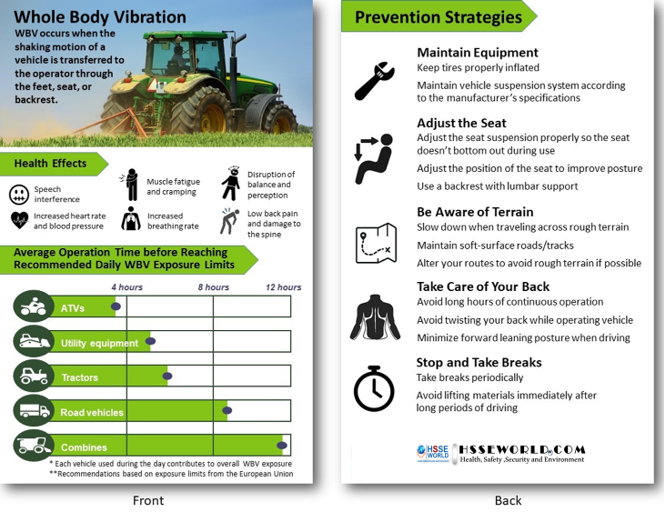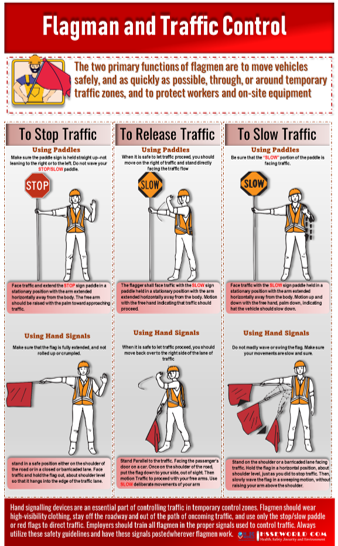Many Workers especially Farmers and bus drivers report musculoskeletal pain, even more so than other industries. Ther report pain in the back, shoulder, arm, hand, and legs throughout their working years. A significant risk factor for back pain is exposure to whole body vibration (WBV). This poster and photo of today identify what WBV is, known health effects, and prevention recommendations. Exposures to WBV can exceed 8-hour recommended limits in as short as 2 hours, depending on the type and age of vehicle being driven. Vibration is lower when pulling a combine, which is heavy and reduces vibration. Farmers operating small vehicles (skid steer loaders) and older vehicles have an increased risk of developing back pain. We have also identified that while new tractors have improved vibration control seats, running these at faster speeds may result in the same vibration exposures as running older tractors at slower speeds. How you operate your equipment affects your risk of exposure to WBV and your risk of developing back pain.
Also Read: E-Books: Managing Noise and Vibration at Work

What causes whole body vibration
Vibration transmitted through the seat or feet (known as whole-body vibration or WBV) Drivers of some mobile machines, including certain tractors, forklift trucks, and quarrying or earth-moving machinery, may be exposed to WBV and shocks, which are associated with back pain. Other work factors, such as posture and heavy lifting, are also known to contribute to back problems for drivers, however further study is needed into the impact of WBV.
What are the health effects of whole-body vibration?
Whole-body vibration can cause fatigue, stomach problems, headache, loss of balance, and “shakiness” shortly after or during exposure. The symptoms are similar to those that many people experience after a long car or boat trip. After daily exposure over a number of years, whole-body vibration can affect the entire body and result in a number of health disorders. Studies of bus and truck drivers found that occupational exposure to whole-body vibration could have contributed to a number of circulatory, bowel, respiratory, muscular, and back disorders. The combined effects of body posture, postural fatigue, dietary habits, and whole-body vibration are the possible causes of these disorders.
Many studies have reported decreased performance in workers exposed to whole-body vibration.
Controlling vibration risks
Employers have to take action to prevent risk from exposure to vibration. They need to consider whether there are other ways or machines that would eliminate the exposure to the vibration, especially where large shocks and jolts are involved. If this isn’t possible the exposure should be reduced to as low a level as is reasonably practicable. This includes:
- introducing control measures whenever your employees’ daily exposure to vibration is likely to exceed the exposure action value, and
- not exposing your employees above the exposure limit value.
Risk is likely to be low for exposures at or just above the exposure action value while exposures closer to the exposure limit value will need more control.
Some controls may take time to put in place, particularly where machines must be replaced or new ways of doing things have to be developed. This would normally require an action plan. The plan should state clearly which managers, supervisors and employees are responsible for its delivery and by when. It should also include the need to test the controls.
Employee responsibilities
Employees also have responsibilities under the Health & Safety at Work Act 1974
The general principles of preventing Whole-body vibration
If employers comply with the Control of Vibration at Work Regulations 2005 and follow HSE’s guidance, it will help them manage the risk of back pain resulting from Whole-Body Vibration. Also, some of the requirements may be relatively straightforward and easy to implement, eg filling in potholes on unmade roads.
These include:
- avoiding risks;
- evaluating the risks which cannot be avoided;
- combating the risks at the source;
- adapting the work to the individual, especially with regards to the design of workplaces, the choice of work equipment, and the choice of working methods;
- adapting to technical progress;
- replacing any dangerous vehicles with non-dangerous vehicles;
- developing a prevention policy that covers technology, organization of work, working conditions, and the influence of factors relating to the working environment;
- giving appropriate instructions to employees.
Also Read: Guide for use Seat belt at the Worksite
Control measures
These include:
- introducing working methods that eliminate or reduce exposure, eg minimizing the transport of goods or materials or replacing manned with unmanned machines such as remotely controlled conveyors;
- choosing work equipment of appropriate ergonomic design, ie the choice of vehicle can be an important means of reducing exposure to vibration, through:
- the difference in vibration emissions of the vehicle itself (although this needs to be considered alongside choosing the most appropriate vehicle for the task);
- visibility should be such that the machine can be operated without stretching and twisting;
- it should be easy to get in and out of the machine by using handholds and footholds so that the temptation to climb or jump is minimized;
- access to manually loaded areas should be unimpeded by the machinery structure and involve minimal lifting, and
- if the machine cab is the sole work of the machine operator, including break time, it should have sufficient space and facilities for rest periods.
- considering the choice of seat (including suspension seats) and the choice of tires,
- regular maintenance of vehicles (including their seats and suspension), and maintenance of unmade roads and ground conditions throughout sites to suit the machines that use them will greatly reduce shocks and jolts.
- designing the layout of workplace sites to reduce the need to transport materials, and so reduce the WBV exposure of drivers/operators;
- providing suitable and sufficient information and training for employees;
- limiting the duration and magnitude of exposure – when all reasonably practicable steps have been taken to reduce the vibration magnitude, and taking account of the fact that there is no personal protective equipment available for WBV, the final resort for compliance with the exposure limit value is to limit the duration of exposure;
- ensuring the work schedules have adequate rest periods – a recommended precautionary measure is to take a short break between operating mobile machinery and manual handling of materials, to give tired muscles time to recover before handling heavy loads,
- protecting employees from cold and damp – cold exposure may accelerate the onset or worsen the severity of back pain. It is good practice to ensure that those working in the cold are provided with warm, and (if necessary) waterproof clothing.
- reducing exposure below the exposure limit value – you must not permit an employee to be exposed above the exposure limit value. Your program of measures must be designed to prevent this level of exposure. If you find the exposure limit value is being exceeded, you must immediately take action to reduce exposure and identify the reason for overexposure.
Also Read: Prevent the risk of injury due to hand-arm vibration
The exposure limit
Employers should not consider reduction below the exposure limit value to be a target – you must reduce exposure as low as you reasonably can. This may mean reducing the time for which the employee uses the machine each day, eg spreading that particular task over several days or sharing it between two or more employees (job rotation).
Occasional exposures above the exposure limit value (weekly averaging of exposure)
On very limited occasions, employers are allowed to average exposures over a week rather than over a day, but only in particular circumstances. This is primarily designed for where workers exceptionally need to carry out work causing uncommonly high vibration exposure in a single day, eg for emergency work. The main conditions are:
- that the person’s exposure is usually below the exposure action value;
- that the risk is less than if the employee were exposed at the exposure limit value for the week.
This flexibility does not remove the duty on the employer to reduce the exposure so far as is reasonably practicable.
Employees whose health is likely to be particularly at risk
Extra care will be needed to ensure that the exposure of those who are particularly sensitive to WBV is kept to a minimum, that they are given and take into account adequate information, instruction, and training, and that symptom of back pain are monitored.
Download the Infographic
Now you can download the Infographic ” Whole Body Vibration” Front and back side and post it at the workplace to communicate with everyone to be familiar with the Whole body Vibration hazards and it’s controls.
Photo of the day: Whole Body Vibration
Download more resources at SAFETY BAG
More photos:
- What are the Best Practices for Managing Subcontractor Risk
- Photo of the day: 10 Essential Safety Tips for Driving in Hot Weather Conditions
- Photo of the day: best workplace safety tips
- Photo of the day: The Importance of Stop Work Authority in Maintaining Workplace Safety
- Photo of the day: Tomorrow’s Reward for Working Safely Today: Cultivating a Culture of Safety
- Photo of the day: Preventing slips and trips at work
- Photo of the day: Learn the DRSABCD action Plan
- Working with Electricity Electrical Accidents Guide for Electrical Workers
- Photo of the day: Hearing Protection Device Selection
- Photo of the day: If An Earthquake Shakes You-Infographic free
- Fire Safety Posters Free Download
- Photo of the day: First Aid for Electrical Burns-Infographic free
- Infographic: First Aid for Cuts and Scrapes free download
- Photo of The day: Work Safe with Lasers-Laser Safety free
- Photo of the day: Working Safely with chemicals and chemical Management
- Photo of the day: Safe work practices when using MEWPs ( updated)
- Photo of the day: Preventing Common Kitchen Hazards
- Photo of the day: Safe handling of Gas Cylinders and lecture bottles
- Photo of the day: Forklift Stability Triangle
- Photo of the day: Defective Tools Safe Work Practice
- Photo of the day: Lift With Your Legs Not With Your Back
- Photo of the day: First Aid for burns
- Photo of the day: The 7 Principles of HACCP
- Photo of the day: Working Safely with Suspended Loads
- Photo of the day: Heat Stroke First Aid and safety posters
- Photo of the day: Near-Miss Reporting and Posters
- Photo of the day: Ergonomic chair and office chair safety tips
- Photo of the day: Whole Body Vibration
- Photo of the day: Substation Safety Equipment
- Photo of the day: Bypassing Safety Controls Rules
- Photo of the day: Lightning Safety Tips
- Photo of the day: Overhead Power lines Clearance
- Photo of the day: Floor Marking
- Photo of the day: Types of Foot Protection
- Photo of the day: Types of Hand Protection
- Photo of the day: Lockout and Tagout Safety
- Photo of the day: Fall Protection Plans
- Photo of the day: Flood Safety Tips
- Photo of the day: Read All Labels Work safe
- Photo of the day: Run Project safely with Crane Hand Signals
- Photo of the day: Flagman and Traffic control
- Photo of the day: Managing Risks of Exposure to Solvents in the workplace
- Photo of the day: Scissor Lift Safety
- Photo of the day: HSE Bulletin Board
- Photo of the day: Arc-Fault Circuit Interrupters (AFCI)
- Photo of the day: Safe use of ladders and step ladders
- Photo of the day: Concrete Truck Driver Hand Signals
- Photo of the day: Extension Cord Safety Tips
- Photo of the day: Protect your Head
- Photo of the day: choosing the right Anchorage
- Photo of the day: Work-Related Asthma
- Photo of the day: Top FIVE Heavy Equipment Construction Site Safety Tips
- Photo of the day: sun safety in the workplace
- Photo of the day: Cannabis and Impairment in the Workplace
- Photo of the day: Position for safety and comfort-Safety Tips
- Photo of the day: Generator Safety
- Photo of the day: Controlling COVID-19 in the Workplace-Physical Barriers
- Photo of the day: Manual Material handling
- Photo of the day: Personal Protective Equipment last resort
- Photo of the day: WHMIS 2015 – Pictograms
- Photo of the day: Indoor Air Quality
- Photo of the day: Noise in the affected workplace
- Photo of the day: Fatigue at Work
- Photo of the day: Don’t be Driven to Distraction
- Photo of the day: working in heat and Humidex Rating
- How to use Plate Clamps Safely: Safety Moment#34
- Photo of the day: Sitting at work
- Photo of the day: 5 ways to reduce the risk of Slipping and Tripping
- Photo of the day: Preventing the spread of contagious illness
- Photo of the day: Incident Investigations
- Photo of the day: 10 Scaffold Safety Essentials
- Photo of the day: Effective Health and Safety Committees
- Photo of the day: New worker Orientation & Safety Orientation checklist
- Photo of the day: Workplace Inspection
- Photo of the day: musculoskeletal disorders
- Photo of the day: Emergency preparedness in the workplace
- Photo of the day: Mental health in the workplace
- Photo of the day: Trenching Safety Tips That Can Save a Life
- Photo of the day: Dangerous Goods Classes
- Photo of the day: Safety Equipment for Confined Spaces
- Photo of the day: Tips to reduce Heat stress in the workplace
- Photo of the day: hierarchy of controls
- Your steps to chemical safety
- H2S Gas and how to handle its Emergency
- Photo of the day: Importance of Mock drill and Fire Action Emergency Procedure
- Photo of the day: Choosing the Right Face Mask and the difference between a respirator and face mask
- Photo of the day: Confined space safety Precautions
- Breath Safely: The Proper Use of Respiratory Protection
- Photo of the day: Electric shock survival
- Photo of the day: Chemical Spill Emergency Response
- Photo of the day: Construction Site fire Safety
- Photo of the day: Confined Space rescue
- Photo of the day: Conveyors Safety Tips





